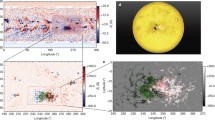Abstract
A major solar active event called Bastille Day Event occurred in AR 9077 on July 14, 2000. Simultaneous occurrence of a filament eruption, a flare and a coronal mass ejection was observed in this event. Previous analyses of this event show that before the event, there existed an activation and eruption of a huge trans-equatorial filament, which might play a crucial role in triggering the Bastille Day event. This implies that independent flux systems are closely related to and affect each other, which has encouraged us to investigate the catastrophic behavior of a multiple coronal flux rope system with the use of a 2.5-D time-dependent MHD model. A force-free field that contains three separate coronal flux ropes is taken to be the initial state. Starting from this state, we increase either the annular or the axial flux of a certain flux rope to examine the catastrophic behavior of the system in two regimes, the ideal MHD regime and the resistive MHD regime. It is found that a catastrophe occurs if the flux exceeds a certain critical value, or the magnetic energy of the system exceeds a certain threshold: the rope of interest breaks away from the base and escapes to infinity, leaving a current sheet below. Moreover, the destiny of the remainder flux ropes relies on whether reconnection takes place across the current sheet. In the ideal MHD regime, i.e., in the absence of reconnection, these ropes remain to be attached to the base in equilibrium, whereas in the resistive MHD regime they abruptly erupt upward during reconnection and escape to infinity. Reconnection causes the field lines to close back to the base and thus changes the background field outside the attached flux ropes in such a way that the constraint on these ropes is substantially relaxed and the corresponding catastrophic energy threshold is reduced accordingly, leading to a catastrophic eruption of these ropes. Since magnetic reconnection is generally inevitable when a current sheet forms and develops through an eruption of one flux rope, the eruption of this flux rope must lead to an eruption of the others. This provides an example to demonstrate the interaction between several independent magnetic flux systems in different regions, as implied by the Bastille Day event, and may serve as a possible mechanism for sympathetic events occurring on the Sun.
Similar content being viewed by others
References
Amari, T., Luciani, J.F., Mikic. Z., and Linker, J.: 2000, Astrophys. J. 529, L49.
Antiochos, S.K., DeVore, C.R., and Klimchuk, J.A.: 1999, Astrophys. J. 510, 485.
Bagala, L.G., Mandrini, C.H., Rovira, M.G., and Demoulin, P.: 2000, Astron. Astrophys. 363, 779.
Cheng, J.X., Fang, C., Chen, P.F., and Ding, M.D.: 2005, Chinese J. Astron. Astrophys. 5, 265.
Ding, J.Y. and Hu, Y.Q.: 2006, Solar Phys. 233, 45.
Forbes, T.G.: 2000, J. Geophys. Res. 105, 23, 153.
Forbes, T.G. and Insenberg, P.A.: 1991, Astrophys. J. 373, 294.
Forbes, T.G. and Priest, E.R.: 1995, Astrophys. J. 446, 377.
Gopalswamy, N. et al.: 1999, Astron. Astrophys. 347, 864.
Hu, Y.Q.: 1989, J. Comput. Phys. 84, 441.
Hu, Y.Q.: 2004, Astrophys. J. 607, 1032.
Hu, Y.Q.: 2005, in K.P. Dere, J. Wang, and Y. Yan (eds.), Coronal and Stellar Mass Ejections, IAU Symp., 226, 263.
Hu, Y.Q., Li, G.Q., and Xing, X.Y.: 2003, J. Geophys. Res. 108, 1072.
Li, G.Q. and Hu, Y.Q.: 2003, Chinese J. Astron. Astrophys. 3, 555.
Lin, J., Forbes, T.G., Isenberg, P.A., and Demoulin, P.: 1998, Astrophys. J. 504, 1006.
Low, B.C.: 2001, J. Geophys. Res. 106, 25, 141.
Mikic, Z. and Linker, J.A.: 1994, Astrophys. J. 430, 898.
Moon, Y.-J. et al.: 2002, Astrophys. J. 574, 434.
Moon, Y.-J. et al: 2003, Astrophys. J. 588, 1176.
Peng, Z. and Hu, Y.Q.: 2005, Chinese J. Space Sci. 25, 81.
Sun, S.J. and Hu, Y.Q.: 2005, J. Geophys. Res. 110, A05102, doi:10.1029/2004JA010905.
Wang, H. et al.: 2001, Astrophys. J. 559, 1171.
Wang, J.X. et al.: 2005, in K.P. Dere, J. Wang, and Y. Yan (eds.), Coronal and Stellar Mass Ejections, IAU Symp., 226, 135.
Wolfson, R. and Low, B.C.: 1992, Astrophys. J. 391, 353.
Zhang, Y.Z., Hu, Y.Q., and Wang, J.X.: 2005, Astrophys. J. 626, 1096.
Zhang, C.X., Wang, H.N., Wang, J.X., and Yan, Y.H.: 2000, Solar Phys. 195, 135.
Zhou, G.P., Wang, J.X., and Zhang, J.: 2005, in K.P. Dere, J. Wang, and Y. Yan (eds.), Coronal and Stellar Mass Ejections, IAU Symp., 226, 200.
Author information
Authors and Affiliations
Corresponding author
Rights and permissions
About this article
Cite this article
Ding, J.Y., Hu, Y.Q. & Wang, J.X. Catastrophic Behavior of Multiple Coronal Flux Rope System. Sol Phys 235, 223–234 (2006). https://doi.org/10.1007/s11207-006-0092-7
Received:
Accepted:
Issue Date:
DOI: https://doi.org/10.1007/s11207-006-0092-7




